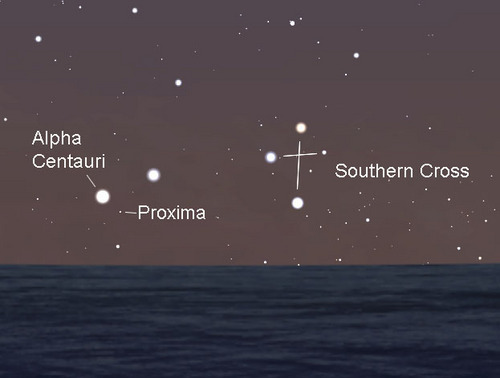
earthsky.org
I may be simple. |
| While
we continue to make progress with the exploration of our solar system,
with breathtaking insights into the moons of Jupiter and Saturn, we
still lack any realistic concept for the direct exploration of our
closest solar neighbours. In 2016, a 'breakthrough'
was announced planning to accelerate lightweight spacecrafts to 15-20%
of the speed of light to bridge the distance of 4.4 lightyears to Alpha Centauri with an estimated travel time of 20-30 years. |
| According
to plans, acceleration will be provided by directing focused laser
beams into 4 by 4 meter lightsails composed of a (still to be
developed) graphene-based light-weight material. The miniature
spacecrafts (with a total mass of a few grams) should in principle just
take pictures once they have reached our closest solar companion,
during a
very fast fly-by. To
compensate for possible falling into malfuction during the long
journey, an armada of 1000 such 'flying mobile cameras' should be sent
along their way. |
| An
illustrious crowd of specialists with high technical competence seems
to
advocate and to support this ambitious
project. Nevertheless, its realization appears still premature, for
several reasons. First of all, the essential pre-requisite is science
fiction: up to now, no light-weight lightsail of sufficient
efficiency and sturdiness is available yet. Second, I wonder whether it
would be wise to provide propulsion by laser beams. And third, Moore's
'law' on the future of computing power (a doubling every 2 years) still
seems to hold. |
| Research
into the technical applicability of graphene is in its infancy.
Due to its excellent properties, there is little doubt that an
efficient lightsail could be made from this material. However, it still
needs to be seen how much energy such a construct can transduce into
velocity without destruction. Probably it will be better to rely on
good old solar power instead of high energy lasers, even if only 10% of
the speed of light can be reached. |
| Another drawback of
using earth-based lasers for acceleration would be that once
accelerated, these tiny aircraft cannot be slowed down except by
other laser canons installed on Proxima Centauri b (for example), an Earth-sized
exoplanet in the habitable zone of Proxima Centauri. Of course,
installation of such instruments is far beyond our possibilities.
However, the star Alpha Centaurus is a close neighbour of the red dwarf
Proxima Centauri and would have sufficient luminosity to efficiently
decelerate our vehicles. |
| This brings me to my
third point: Once these tiny machines were more the 4 lightyears away
from our solar system, no meaningful exchange of information would be
possible. They will have to decide everything for themselves. Of course,
we would very much like them to shift into orbit e.g. around Proxima
Centauri b and to send us pictures from there. To achieve that, the
little aircraft would have to process a lot of information and must be
equipped with a means to orient their lightsails appropriately. |
| This
high demand on information processing can only be met by very efficient
hardware and software. Both are subject to ongoing developments. My
proposal would be: Let's wait for another 20 years before we start
investing into such a project. Lets exploit both stars for providing
the necessary acceleration / deceleration energy: our own sun, and the
most powerful star of the approached trinary star system. |
| The largest solar sail produced as of 2013 was Sunjammer,
forseen for launch into orbit for 2015 (but finally cancelled). With an
impressive area of 1200 m2 and a thickness of only 5 Ám, the area
density of the polyimide foil (mass density 1.42 g/cm3) was
considerably below that of regular printing paper (7.1 << 80
g/m2).
Nevertheless, this value was still far above the theoretical value for
keeping the balance between gravity and solar light pressure (0.78 g/m2; not to mention the equipment to carry). A single molecular sheet of graphene weighs 0.00037 g/m2 ... |
| One
property we will surely need for such a project is patience. Most
likely, none of the people involved in its development will live to see
the first results. But future generations will expect with excitement
the news sent to us from a far distant world. If the procedure works,
more instruments will be sent to other neighbouring solar systems. This
will give us the possibility to improve the techniques involved. With
the right materials at hand, it may turn out as relatively simple and
inexpensive. |
| 4/18 < MB
(4/18) > 10/18 |
| Heller R & Hippke M (2017) Deceleration of high-velocity interstellar photon sails into bound orbits at alpha-Centauri. arXiv:1701.08803v1 |
| Heller R, Hippke M, Kervella P (2017) Optimized trajectories to the nearest stars using lightweight high-velocity photon sails. arXiv:1704.03871v2 |
| More realistic concepts for nearer targets |